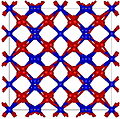Europium(III) oxide (Eu2O3), is a chemical compound of europium and oxygen. It is widely used as a red or blue phosphor in television sets and fluorescent lamps, and as an activator for yttrium-based phosphors. It is also an agent for the manufacture of fluorescent glass. Europium fluorescence is used in the anti-counterfeiting phosphors in Euro banknotes.[2]
Europium oxide has two common structures: Monoclinic (mS30, space group C2/m, No. 12)[3] and cubic (cI80, space group Ia3, No. 206).[4] The cubic structure is similar to that of manganese(III) oxide.
It may be formed by ignition of europium metal.[5][6]
It can react with acids to form the corresponding europium(III) salts.
Gallery
-
Cubic Eu2O3
-
Monoclinic Eu2O3
References
- ^ Webelements Europium trioxide
- ^ "Europium and the Euro". Archived from the original on 2009-08-04. Retrieved 2009-06-04.
- ^ "ICSD Entry: 631453". Cambridge Structural Database: Access Structures. Cambridge Crystallographic Data Centre. Retrieved 2022-07-04.
- ^ Heiba, Z. K.; Akin, Y.; Sigmund, W.; Hascicek, Y. S. (2003). "X-ray structure and microstructure determination of the mixed sesquioxides (Eu1−xYbx)2O3 prepared by a sol–gel process". J. Appl. Crystallogr. 36 (6): 1411–1416. doi:10.1107/S0021889803019319.
- ^ Ugale, Akhilesh; Kalyani, Thejo N.; Dhoble, Sanjay J. (2018). "Chapter 2 - Potential of europium and samarium β-diketonates as red light emitters in organic light-emitting diodes". In Martín-Ramos, Pablo; Ramos Silva, Manuela (eds.). Lanthanide-Based Multifunctional Materials: From OLEDs to SIMs. Elsevier. pp. 59–97. doi:10.1016/B978-0-12-813840-3.00002-8. ISBN 978-0-12-813840-3.
- ^ "Europium". ScienceDirect. Elsevier. Retrieved 2022-07-04.
Europium is the most reactive rare-earth element... It swiftly oxidizes in air, ignites in the range of 150–180°C to form Eu3+ oxide (Eu2O3).




Recent Comments